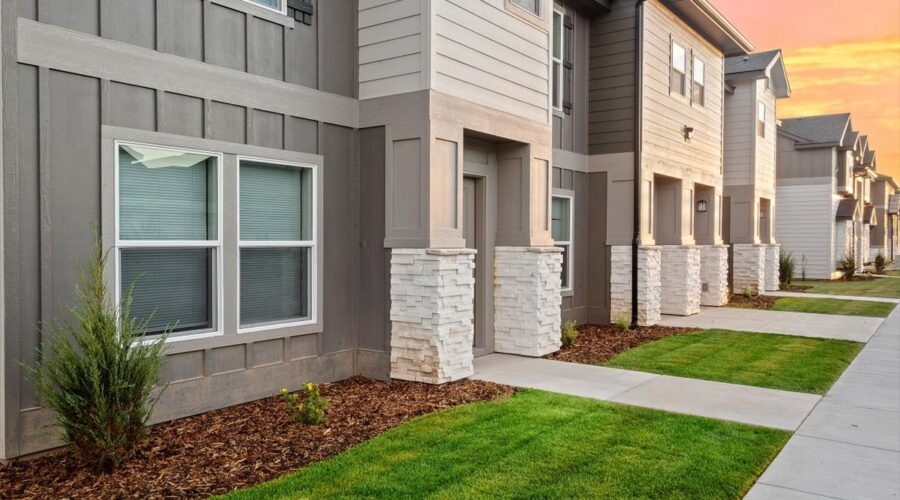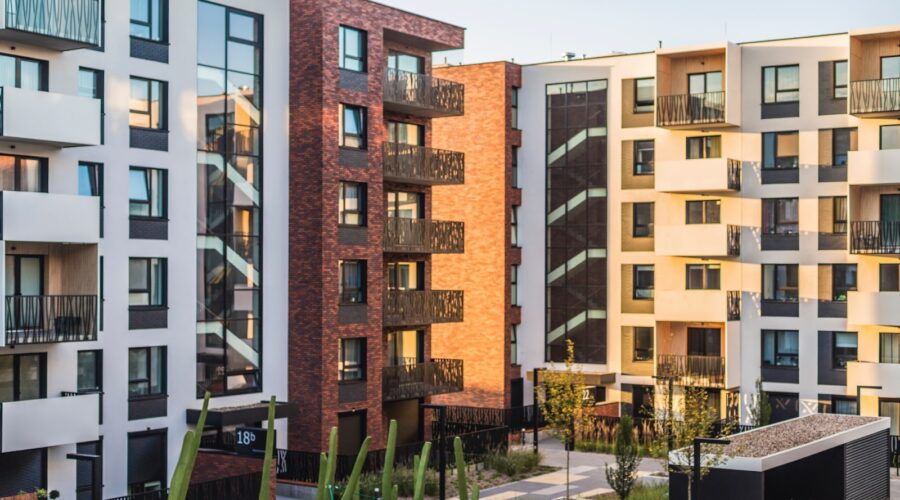If a multifamily asset grows in value, the investors can walk away with more money in their pockets at the time of sale. This is a guiding principle of real estate investment, but reaching it can be a winding path. Read on to learn some of the best methods to increase the value of an apartment building and some common pitfalls to avoid.
Life Bridge Capital is a leading real estate syndication company. We offer our investment partners the opportunity to leverage shares of multifamily rental properties into a passive monthly income. Learn More
Increasing Value as an Investment Strategy
Methods for increasing value vary depending on the investment strategy and the class of an apartment building. Have a plan in mind when embarking on a project to improve the building’s value.
Turn-keyapartments need only to be maintained and should be an immediate and steady source of income. Renovations to these buildings may not yield increased revenue or value to warrant the expenditures.
Conversely, investors of value-add or distressedapartments plan to improve the property in ways that increase occupancy, command higher rents, and ultimately increase the property’s value.
What Are Value-Add Apartments?
Value-add apartments are typically Class B or C apartments that already boast stable occupancy. They can better compete with similar properties and draw higher rent through aesthetic upgrades, improved amenities, and increased productivity/efficiency of business operations.
Value-add apartments remain a favorite of investors, because they are among the least risky multi-family properties.
Distressed Properties
Class C and D apartments that require significant renovation, perhaps even structural repair, are considered distressed properties. They are riskier than value-add properties because occupancy and revenues are lower, meaning they may have little or no positive cash flow. Investors will need deep pockets to make enough improvements to lift these properties out of distress and make them more enticing and valuable at future sale dates.
Determining Value
The value of apartment buildings is most often determined using the income-based valuation method. The value is found by dividing the net operating income by the capitalization rate. As a result, property renovations and improvements are crucial to increasing value by increasing the net operating income. This happens by increasing revenue through higher occupancy and rents and decreasing expenses through improved efficiency and lower costs.
Aesthetic Improvements and Renovations
Many adages try to instill in us that surface-level things lack value. Still, surface-level features will be a deal-breaker for many prospective tenants in the rental market, particularly for Class B properties.
Influencers and home blogs make comparing one’s living space to current trends more insidious than ever. We no longer view each other’s homes only in person. Instead, we see how the most distant of strangers and acquaintances live through social media, Zoom backgrounds, and online school. When looking at listing photos and touring the property, hopeful renters will be considering whether the property is a suitable place to bring their peers, coworkers, and customers.
Aesthetic concerns are just as applicable for Class C and D buildings. Beat-up, defunct, and outdated interiors serve as a constant reminder that tenants are settling for what they can afford, and they will be quick to move on as soon as possible if they choose the building at all.
Be judicious when implementing interior upgrades. They can be among the most expensive, so do plenty of market research to ensure that the enhancements will yield increased revenues and building value to offset the cost.
Here are some potential improvements and renovations that can increase the value of an apartment building:
1. Paint and Flooring
Fresh paint and flooring are a must-have for distressed properties and can elevate Class B and C properties to win tenants in a competitive market. Determine where the building fits in the tug between luxury and economy, and update accordingly.
The temptation to upgrade on an incorrect scale leads to project failures. Implement changes to bring the building into a target rent threshold, not above or below. For example, laminate countertops will cause prospective tenants in the upper rent ranges to turn away but could be satisfactory in a budget-focused building.
2. Appliances
Appliances appeal to both the aesthetics and functionality of a rental home. Even for those who prefer take-out to home-cooked, high-end appliances are a highly noticeable status symbol in an apartment.
3. LED Lighting
LED lighting is a no-brainer for long-term investors who intend to keep a property for several years. LED lights have a 25-year life expectancy and conserve energy, leading to utility savings and reduced labor fees for bulb changes.
Amenity Upgrades and Additions
Change a building’s status by creating new or improving existing amenities. Attractive amenities make a multifamily asset more competitive, which increases occupancy and warrants higher monthly rents. Carefully planned and well-executed amenities elevate apartments into better property classes and can do much to demonstrate that a building is rehabilitated and worthy of a new reputation.
Here are some amenities that can help to increase the value of an apartment building:
1. Swimming Pool
Depending on the location of a property, swimming pools can be a must-have or a never-used amenity. Know that Class A and B properties require much more than the concrete, in-ground rectangles that remind us of our municipal swimming pool childhoods. Landscaping and furniture turn a children’s summer distraction into an oasis for which adults are happy to pay.
Regardless of the traffic expected, if a swimming pool exists, ensure it is always clean and in good repair. Dilapidated swimming pools will tank an apartment’s appearance and reputation.
2. Fitness Center
Like swimming pools, a neglected fitness center can cause more harm than the complete lack of one. Common areas like pools and fitness centers create an image in tenants’ minds regarding the upkeep and status of the property.
The best fitness centers include locker rooms, saunas, and a variety of cardio and weight equipment to replicate the experience of a gym membership. Consider high-end equipment and instructor-led classes to warrant gym or class fees.
Fees and Extra Services
Premium services and fees can be another source of value for apartment buildings:
1. Premium and Permit Parking
Buildings that have on-site parking have multiple opportunities to make those spaces produce money. First, implement a permit system to assess fees on each vehicle. Tenants will pay for the convenience of parking spaces close to doors or elevators, so advertise them at a higher rate than general parking.
2. Vending Machines
Vending machines are usually owned and maintained by a third-party company, and the building contracts with these companies to receive a portion of the sales. These machines can turn into money-makers for buildings, because the cost and maintenance do not fall on the building.
Do not limit the machines to only candy and soda. They can serve as an unattended bodega in the building by offering over-the-counter medicines, toiletries, cleaning and laundry supplies, and more.
3. Valet Trash and Recycling
Doorway pickup of trash and recycling has the double benefit of keeping the building clean and free of rubbish and generating additional income. Valet trash services can be performed by outside contractors or regular maintenance staff.
4. Laundry
Rather than funneling tenants to a laundromat or laundry services, turn those renters’ expenses into business income. If space allows, rent in-unit washers and dryers to tenants or charge a premium for apartments that offer in-unit laundry. Alternatively, place coin-and-card-operated machines in a common area.
5. Pet Fees
While Fair Housing laws prevent landlords from discriminating against tenants with children, no such laws protect pets. Many landlords prohibit pets on the assumption that they will damage the unit, but those who do so overestimate the damage and miss out on a lucrative income stream: pet rental fees.
A nationwide research study found that, on average, tenants with pets incurred about $40 more in damages than those without pets. In comparison, tenants with children caused $150 more in damages than those without children.
Base the monthly fees on the pet type, size, and number. Simply allowing pets widens the pool of prospective tenants. The same study found that 82 percent of pet owners have had challenges finding a rental that allowed their companion animals.
Due to those challenges, pet owners tend to stay in a unit longer, thereby reducing vacancy and turnover expenses.
More Ways to Add Value
1. Optimize Square Footage
Understanding the building’s clientele will improve the profitability in numerous ways, one of which being the rentability of specific units or layouts. Optimize the design and size of units to appeal to the tenant demand in a specific market.
For example, suburban tenants of Class B and C buildings tend to demand 2-and-more-bedroom units to accommodate families. In contrast, city-center multifamily assets will find tenants satisfied with smaller, single-bedroom or studio units.
2. Add Covered Parking
Carports and garages protect vehicles from the elements and can provide much-needed storage. Tenants will pay a premium to avoid costly insurance claims and extend the life of their vehicles.
3. Improve Business Operations
Even if every one of the above tangible changes is implemented, a building will fail to meet its maximum value with poor staff, inefficient procedures, high tenant turnover, and slow unit turnaround. All of these factors result in lower occupancy, less rental income, and increased expenses.
The number one way to improve operations is to hire a reliable property manager. The property manager touches all aspects of the building, from choosing subcontractors to minimizing vacancies. This person and their team ensure that the property puts on an excellent public face to current and prospective tenants by coordinating maintenance, groundskeeping, and any other needed services.
Final Thoughts
When purchasing a distressed or value-add property, investors must be conscious of the possible returns for each upgrade or renovation and be attuned to the building’s placement in the market. Just as all home projects do not lead to a dollar-for-dollar increase in value, neither do multifamily housing upgrades.
Ideally, renovations will increase a building’s revenues, and consequently, its value. Poorly planned or executed changes only serve as money pits and can spell ruin for the most promising of investments.
Life Bridge Capital is a leading real estate syndication company. We offer our investment partners the opportunity to leverage shares of multifamily rental properties into a passive monthly income. Learn More


